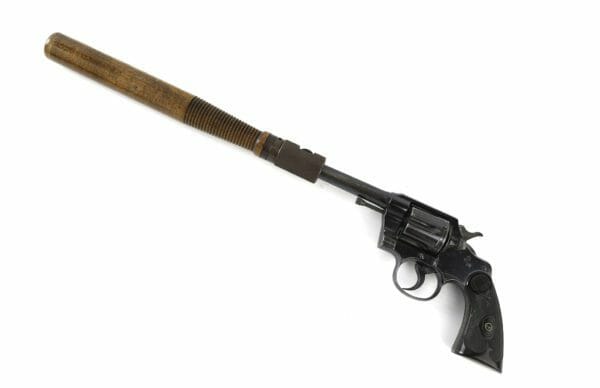U.S.A. – -(Ammoland.com)- It’s a billy club; it’s a gun; No, it’s a “Combination Policeman’s Truncheon and Extension Pistol Barrel.” Or, at least that’s what inventor Edward Norton Moor of California called it. He applied for the patent in December 1916 and received approval in October 1918.
I had a chance to handle one of these odd billy club extensions and even got to shoot a revolver outfitted with one at the range. Here are a few things I learned: I discovered that the club, at least the one I used, is actually designed to be used on a Colt and not a Smith & Wesson, even though the patent documents don’t stipulate usage on a particular make or model. Manipulation of the attachment ring was difficult and it didn’t engage completely with the front sight on an S&W Military & Police (later, the Model 10) revolver. When I switched it over to a Colt Army Special, it fit perfectly. The club slid onto the barrel and locked securely in place on the Colt’s front sight.
From there, it was time to actually see how well the Colt would shoot with this contraption on the barrel. The patent calls for a front sight on the club, which is comprised of a spring and a screw. However, this didn’t make it to production as the actual unit doesn’t have a front sight, nor is there a spot for one.
Firing the revolver was a breeze as far as the attachment was concerned. It did not have an effect on the point of impact when I was shooting it. My shots grouped the same with and without the attachment.

The final test was to try the club aspect of the design. With my hand wrapped around the grip and none of my fingers in the trigger guard, I approached my cardboard assailant and landed four blows. The club stayed firmly attached the entire time and was not loose at the end of the encounter. Now, obviously hitting cardboard isn’t like hitting a human being in a skirmish, but this proved, at least, that the club can be effectively swung at a target while attached to the gun.
It’s a neat concept, but I don’t think there’s any surprise as to why it didn’t catch on. Even though I made sure the gun was empty and my fingers weren’t near the trigger, I don’t know if every officer – in the heat of the moment – would make sure to be as safe were they to need to use it, and doing otherwise could easily cause a negligent discharge, even with the heavy trigger pull of a double-action revolver.
About Logan Metesh
Logan Metesh is a historian with a focus on firearms history and development. He runs High Caliber History LLC and has more than a decade of experience working for the Smithsonian Institution, the National Park Service, and the NRA Museums. His ability to present history and research in an engaging manner has made him a sought-after consultant, writer, and museum professional. The ease with which he can recall obscure historical facts and figures makes him very good at Jeopardy!, but exceptionally bad at geometry.

